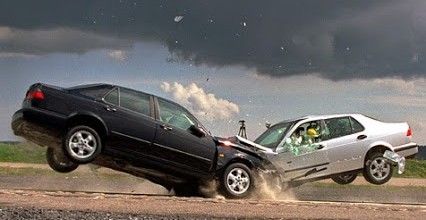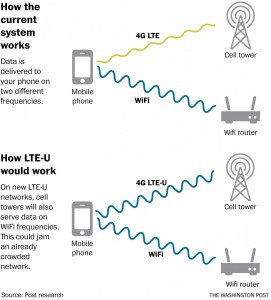Can LTE Unlicensed Steamroll Wi-Fi?
A recent article in Washington Post seems to be confusing people. In “The future of mobile data pits cellphone carriers against cable giants,” Brian Fung claims, among other things, that LTE-Unlicensed can destroy Wi-Fi by simply shouting over Wi-Fi transmissions:
Because it has to share the airwaves with so many other wireless devices such as Bluetooth headsets and wireless mice, WiFi antennas follow a “politeness” protocol that controls when they transmit and receive data. When your smartphone is on WiFi and it senses other devices communicating over the same frequencies, it backs off until the channel is clear. It’s a lot like the automotive principle of yielding to pedestrians in a crosswalk.
That’s not the case with today’s LTE technologies, in part because LTE was designed with proprietary networks in mind. So if left unchecked it could prevent WiFi devices from uploading or downloading content from the Internet — the equivalent of running through the crosswalk, the next five stoplights and over whoever might be in the way.
While it’s true that unlicensed spectrum systems that don’t have any sort of politeness protocol would harm those that do, the article fails to appreciate that “running through a crosswalk” would harm LTE-U as much as it would harm Wi-Fi, so LTE-U doesn’t work that way. It’s not so much that LTE-U is a car and Wi-Fi is a pedestrian as it is that they’re both cars. So why do you yield to traffic moving past your car at an intersection instead of plowing through? The question answers itself, doesn’t it?
In the wireless scenario, overlapping transmissions make both packets impossible to decode, which leads to retransmission. It takes less time to wait for in-flight packets to finish than to force a collision and still have to retransmit even later. This wouldn’t make any sense.
Fung bases his belief in bad driving on LTE-U’s part from a study Google presented to the FCC, “LTE and Wi-Fi in Unlicensed Spectrum: A Coexistence Study” by Google engineers Nihar Jindal and Donald Breslin. The trouble with the study is that it’s utterly artificial and speculative, as the Google engineers readily admit:
In order to measure the effectiveness of LTE-U’s coexistence mechanisms, a series of tests was conducted of retail Wi-Fi equipment operating in the presence of emulated LTE-U transmissions. Since LTE-U equipment is not yet available, LTE-U transmissions were emulated with a signal generator, using the description of LTE-U coexistence mechanisms contained in LTE-U Forum documentation. (Emphasis added.)
That’s right: The “coexistence study” pitted retail Wi-Fi products against a fake LTE-U signal generator that simply turned on and off at random intervals and didn’t have any way to detect or react to collisions. A signal generator doesn’t listen, it only talks. So what could a side-by-side test like this possibly prove except LTE-U is a tank and Wi-Fi is a pedestrian? How embarrassing.
The most important thing to realize about LTE-U and Wi-Fi coexistence is that neither one has any stake in knocking out the other’s transmissions. This is simply because failing to recognize the way the second-largest application in unlicensed (after Bluetooth) works would be fatal for real LTE-U systems, which are much more sensitive to correct transmissions than signal generators are — infinitely more, to be precise.
This doesn’t necessarily mean the Google engineers were deliberately dishonest as much as that they are somewhat poorly informed. The only source they cite for details on LTE-U operation is the web site of the LTE-U Forum, not a specific document. And from the Web site perusal, they claim:
LTE-U’s primary coexistence mechanism—duty-cycling (i.e., cycling LTE-U through on/off periods) when a Wi-Fi access point is detected at a level above -62 dBm—can reduce the throughput of Wi-Fi devices significantly below the reduction associated with fair sharing, as well as significantly increase Wi-Fi latency.
While duty-cycling is one of the sharing mechanisms in LTE-U, it’s a stretch to say it’s the primary one. Duty cycling — a technique used in other wireless systems such as Ultra-Wideband to ease coexistence between users of unlicensed spectrum — ensures that LTE-U will never attempt to use more than half of the spectrum in a given band. This by itself would ensure that Wi-Fi has a fair slice of transmit opportunities, but LTE-U doesn’t stop there. LTE-U observes all the physical layer mechanisms Wi-Fi has defined for clear channel assessment and politeness; Dino Flore explains this in an upcoming High Tech Forum podcast on the work being done for the 3GPP 5G standards.
It’s also incorrect for the Google engineers to assume that the LTE-U work is all done, the specs are complete, and their emulation is 100% accurate. If these assumptions were correct, there would be actual products for them to test and it wouldn’t be necessary to cobble together a simulation, would it?
I’m going to go out on a limb and suggest that the best way to ensure efficient coexistence between Wi-Fi and LTE-U is to pursue the same path that Wi-Fi and Bluetooth followed to resolve their early coexistence issues: work together. It may well be the case that duty-cycling won’t work well in the field because Wi-Fi doesn’t understand it (yet). If that’s the case, it can either be abandoned by LTE-U (they have no reason to plow forward with a sharing scheme that won’t work) or it will be accommodated in some future version of Wi-Fi as Bluetooth avoidance was.
The thing that I find most puzzling about the claims Google has made about LTE-U is how poorly they reflect on that company’s commitment to spectrum sharing. The White House’s PCAST Report on spectrum sharing claimed: “More Efficient and Immediate Use of Federal Spectrum will be Obtained through Sharing” and recommended a focus on receivers over transmitters (slide 9). The PCAST Report reached these conclusions because its leader – Google chairman Eric Schmidt – pushed them in that direction. So here we have a real world opportunity to examine how to bring about efficient sharing of unlicensed spectrum and Google falls back on a transmitter-based approach and declares that sharing won’t work. That’s mighty odd.
All parties desiring to use shared spectrum – whether it’s licensed or not – have an incentive to share efficiently, and simulations that ignore those incentives and the early and provisional nature of current proposals are doomed to fail.
So I don’t blame Brian Fung for getting these facts wrong because he’s a reporter and not an engineer. But I do think Google could be a little more diligent on their side and not pass off mere speculation about coexistence as a proven fact. LTE-U isn’t even in beta yet, after all.
There’s a much more balanced and thorough report on the coexistence challenges in Fierce Wireless Tech by Monica Alleven. Her conclusion is sound:
Verizon and technology partners Alcatel-Lucent, Ericsson, LG Electronics, Qualcomm Technologies and Samsung formed the LTE-U Forum in April 2014. Since then, they have conducted extensive review of LTE-U/Wi-Fi coexistence through computer simulations, lab testing and over-the-air testing, according to [William Stone, executive director of radio access network planning for Verizon].
“All simulations show that when LTE is simply deployed in unlicensed spectrum without the above coexistence mechanism, LTE causes significant performance degradation on coexisting Wi-Fi access points,” he stated. “But when these coexistence mechanisms are implemented, LTE-U behaves as a comparable neighbor to Wi-Fi compared to Wi-Fi as a neighbor, while LTE-U significantly outperforms Wi-Fi.”
T-Mobile US has been one of the more aggressive U.S. operators to promote Wi-Fi calling and, in its filing, it reiterated its plans to deploy LTE-U in 2016. The carrier pointed out that there is meaningful overlap in membership of 3GPP, IEEE 802.11, as well as the Wi-Fi Alliance, to ensure collaboration.
Fung also has a conceptual problem with how LTE-U works. His story contains a graphic suggesting that LTE-U communicates directly with the cell tower:
Nope, doesn’t work that way at all. LTE-U uses a small device in the home, office, or coffee shop the size of a microcell or a Wi-Fi access point. And even when this device is installed, Wi-Fi will continue to serve as an alternate download channel to your phone.
So no, the sky is not falling for Wi-Fi but some of our reporters could look for a little more balance when they describe it. Follow Fierce Wireless Tech if you need a model.




